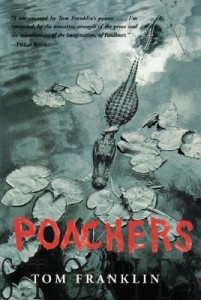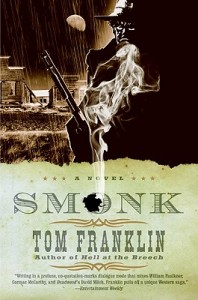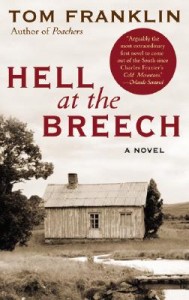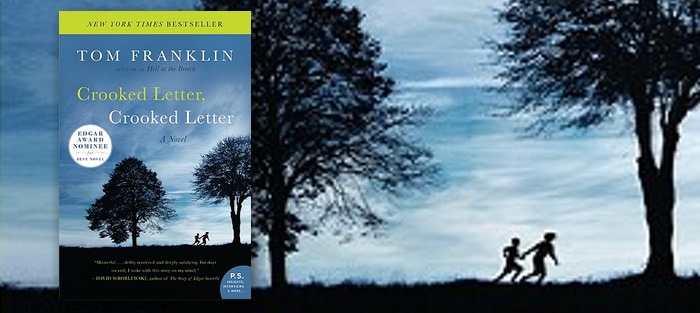Confession: I read Tom Franklin’s Crooked Letter, Crooked Letter on my Kindle. Forgive me, ye book lovers of old. But this being the first, and only, novel I’ve read on my new Kindle, I often found myself wondering if the e-book form was affecting my experience of the novel. Even as I lost myself in the e-ink pages, thoroughly enjoying Franklin’s story of two old friends—one white, one black—coming to terms with long buried issues exhumed now by circumstances—a mysterious local murder—beyond their control, I couldn’t shake these questions. Was I reading differently? Did I have the same expectations for an e-book? The same desires, even? Clearly I’d been spending too much time with my genre theorist friend, who’s always muttering her mantra, “Context is all.” I’m too polite to disagree to her face. But here I wonder: is it? Really?
***
Before I answer that question, a not-quite disclaimer: if Tom Franklin was any other kind of writer, this would be a biased review. Because his debut story collection, Poachers (1999), was one of those books that found me at just the right time: I was twenty-three years old and working at HarperCollins Publishers, the house that been publishing Franklin under their William Morrow imprint since his debut, when on my first day of work I found his book leaning on the dusty shelf of my very own cubicle. I had graduated with an English degree a few years prior, and I’d sought out this Editorial Assistant job to get close to writing. Real writing. Professional writing. I thought I might learn something crucial through sheer proximity. I hoped I would. My whole life I’d written, and yet I still hadn’t found myself as a writer.
Then, on a slow day when my boss was out of the office, I read Poachers. The book did not tell me who I was as a writer, but it told me who I wanted to be.
Many of us have had these moments, and in many ways they are inexplicable, so I won’t try to explain here what I felt or thought. All I’ll say is what I think we can all agree on: these fateful books, they stick with you. So of course I carried my affection for and respect of Poachers with me as I sought out each of Franklin’s future books: Hell at the Breach (2003), Smonk (2006), and most recently, Crooked Letter, Crooked Letter (2010). The discovery I’ve made with each and every new book of Franklin’s is that though this affection of mine is unyielding it is also a misguided basis for my expectations, because with every new book Franklin seemingly sets out precisely to subvert expectations, not just mine and those of his other fans, but those of the genres in which he operates.
***
There is a distinction to be made between the context of a form, like an e-book, and the context of a genre, like murder mystery. But both offer a set of expectations. Take TV for example: the form would be a TV show; the genre might be a sitcom. We expect certain things from a TV show, as opposed to, say, a film, and we also expect certain things of a sitcom that we wouldn’t expect of the nightly news. From book to book Franklin has made the conscious choice to change the context, that is the genre and genre expectations, within which he’s operating. That’s why, despite any affection I might have, this isn’t and can’t be a biased review. Tom Franklin of Crooked Letter, Crooked Letter is radically different than Tom Franklin of Poachers or any of his other books—at least when it comes to the types of stories he tells. After Poachers, the most traditionally “literary” of his works, he wrote Hell at the Breach, a “historical fiction” novel. Hell was followed by Smonk, a “western.” And now, with Crooked Letter, Crooked Letter, he has written a “murder mystery.” But all these genre descriptions are also, in Franklin’s case, horribly reductive.
Let me explain via his most recent, and very accomplished, example.
 The driving plot element behind Crooked Letter, Crooked Letter is the disappearance of a local girl, Tina Rutherford, daughter to the owner of the Rutherford Mills, a business that serves as the only financial lifeline in the tiny hamlet of Chabot, Mississippi. When the girl goes missing, a casual blame falls on Larry Ott, our first suspect. Larry, a now middle-aged white man, is the town outcast who, despite never being convicted, is widely believed to have killed (and possibly raped) a girl he hardly knew but had had a crush on when they were both teenagers. Larry lives on his parents’ expansive property, which is chock full of timber that Rutherford Mills would love to get its saws on. His father (whose business, Ottomotive Repair, Larry inherited) has passed away; his mother is in a nursing home and slowly turning herself over to the horrible wonders of dementia. Larry is as much of a loner as one can be.
The driving plot element behind Crooked Letter, Crooked Letter is the disappearance of a local girl, Tina Rutherford, daughter to the owner of the Rutherford Mills, a business that serves as the only financial lifeline in the tiny hamlet of Chabot, Mississippi. When the girl goes missing, a casual blame falls on Larry Ott, our first suspect. Larry, a now middle-aged white man, is the town outcast who, despite never being convicted, is widely believed to have killed (and possibly raped) a girl he hardly knew but had had a crush on when they were both teenagers. Larry lives on his parents’ expansive property, which is chock full of timber that Rutherford Mills would love to get its saws on. His father (whose business, Ottomotive Repair, Larry inherited) has passed away; his mother is in a nursing home and slowly turning herself over to the horrible wonders of dementia. Larry is as much of a loner as one can be.
But Larry has a friend in Silas “32” Jones. Or does he? Silas, our sleuth, has returned to Chabot after many years away and has found himself now working as the town’s Constable. It’s a thankless job: he spends most days directing traffic at the lumber mill; he drives a department-issued beater of aJeep; he finds his daily pleasure in the company of Angie, an EMT, and in an end-of-the-day beer or three downed at the Chabot Bus, which is no more than an old yellow school bus on blocks that was gutted and converted into a bar with plastic tables inside. Silas’s is an ordinary life, at least as ordinary as it can be for a black man in a position of authority in rural Mississippi. More often than not, though, even this distinction means little, as he seldom has any cause to confront people or exercise his authority. That is, until murder hits his hamlet: once with the Rutherford girl. Again with a local drug dealer. And almost, possibly, a third time, when someone—a masked man we meet in the opening pages—takes the law into his own hands and attacks Silas’s childhood friend, Larry Ott, the widely suspected culprit with whom Silas shares a complicated past, sending Larry into a coma before he can be cleared or charged of any wrong-doings.
If this sounds familiar, it’s because Franklin is using readily identifiable hallmarks of the murder mystery genre: we have our sleuth, our suspect, our murders. We open with a mysterious and anonymous attacker, which creates a degree of dramatic irony in that the reader knows more about the attack on Larry than do any of the characters in the novel. And all of this is delivered to us in short clue-sprinkled chapters broken into even shorter sections, a classic tool (and one I’ll come back to) used in murder mysteries to control pacing and build suspense.
Yet, it would be doing Crooked Letter, Crooked Letter a disservice to label it a murder mystery, because though Franklin employs many of the conventions of the genre, he does so, it seems to me, precisely because they are so formulaic: readers have encountered these conventions so many times that we can’t help but have expectations for these types of stories, and, as Franklin seems to know full well, expectations are a prerequisite of surprise. He uses our context against us, and in so doing he is able to create a new context, a surprising context that is his and his alone, that unique thing I’ll simply call a Tom Franklin novel.
***
But how does Franklin avoid confinement by these expectations? How does he manage to engage these genre conventions and not be strapped into their narrative formula? In the case of Crooked Letter, Crooked Letter, he achieves this tricky end by attending to the most basic distinction between “literary” works and “murder mysteries”: the differing emphasis on character in one and plot in the other.
 Based upon the above description regarding what the novel is about, you might be able guess how this novel ends. Silas, our sleuth, tracks down the killer, and Larry—whether he emerges from his coma or not—has his reputation cleared. That is what our genre expectations likely lead us to believe, but that is precisely because the genre of murder mysteries is one that privileges the what above the who. Franklin is operating in a context in which plot has long been king, and he has authored an uprising of the people. Those people are Silas Jones and Larry Ott, our two main characters, both flawed and hopeful and scared and human. Franklin has infused a genre of what with that most important element of “literary” works: character.
Based upon the above description regarding what the novel is about, you might be able guess how this novel ends. Silas, our sleuth, tracks down the killer, and Larry—whether he emerges from his coma or not—has his reputation cleared. That is what our genre expectations likely lead us to believe, but that is precisely because the genre of murder mysteries is one that privileges the what above the who. Franklin is operating in a context in which plot has long been king, and he has authored an uprising of the people. Those people are Silas Jones and Larry Ott, our two main characters, both flawed and hopeful and scared and human. Franklin has infused a genre of what with that most important element of “literary” works: character.
The results provide surprise not just as genre subversion, but also in the most literal definition of the word. Silas does, as we’d expect, find and confront the killer in the novel’s climax, but it isn’t the result of his thorough gumshoeing; rather, it is by accident. And in that moment, Silas, our sleuth, is more surprised than we are.
If this success via happenstance seems less satisfying than success via hard-nosed detective work, that, I think, is the point. Because Franklin has created such fully-fleshed and sympathetic characters in Silas and Larry, he is no longer dependent upon the what of the novel, the plot points, to perfectly scaffold to a payoff moment in the climax. By the point we’ve reached this climactic moment, we don’t care what happens; we care who it happens to. Silas “32” Jones. Larry Ott. Old friends with old secrets. Our genre-influenced investment in the plot has been replaced by our investment in these characters.
***
But what about that Kindle thingamabob? The Kindle provides the context for form rather than genre. We don’t read books on Kindles, we read e-books. There are differences: most e-reader screens are smaller than the typical 5’ x 7’ page; one has to hit a button to “turn the page” more often than one would actually have to lick a thumb and flip; one also doesn’t know what page number he or she is on with an e-book, rather what percentage of the book he or she has completed. A smaller screen means less text on each “page,” which in turn means more “pages” to process. That may feel like extra work. And while the story in the Crooked Letter, Crooked Letter e-book may be exactly the same as the one we could read in hardcover, our digestion of that story through different mediums—and the amount of work that goes into that digestion—could very well make us expect different stories, or at least different pacing.
We are trained as readers of the paper medium, let’s remember, and so we are used to hitting certain plot points, complications, climaxes, resolutions, etc. after approximately so many page turns. These expectations, too, of course, differ with every genre. But to put this conversation in some historical perspective, let us look at previous changes to the “literary” novel. Though I am sure there are exceptions to the following observation, it seems to this author that the refashioning of the printing press in the mid to late 1800s was a technological change that led to a shift in novel form, at least in Anglo literary novels. The days of Dickens and the serial paradigm, which necessitated a certain plot-heaviness with cliffhangers marking the end of every serialized chapter, were coming to a close. Ahead were the years in which the bound book would appear first in its entirety. This change marks the period of the modern “literary” novel as we know it, in which the pacing has slowed and character interiority is prized over plot.
The change from the printed novel as we know it to the e-book may also bring with it some changes to our expectations for the form.I, and others, suspect we readers may grow less patient (how many times do I have to read this small screen and press this darn button before I find out?) with long, interiority driven novels. Chapters that feel perfectly normal on paper may feel a bit long in an e-book. If I and others are right, and if e-books do become the dominant medium and remain in a form similar to the one we currently consume, we may well adjust our expectations for typical “literary” novels to become much more like Crooked Letter, Crooked Letter. That is, a character-driven novel that employs the structural conventions of a murder mystery—the short chapters meant to draw out suspense, control pacing, and keep your reader flipping the page. With new forms come new form contexts, and to satisfy these possible expectations for expedited payoffs we might have to change our contextual understanding of what “literary” means.
***
 Change. I feel all I’ve spoken of are the ways in which Franklin is always changing: novel to novel, context to context, and now, perhaps, even form to form. But there is much to say for the consistencies in Franklin’s work too. He draws the south—Mississippi in Crooked Letter, but he’s plumbed Alabama too—in a warm-hearted, sympathetic but not uncritical way that few others I’ve read have managed to. He is a man of the south (he grew up in Dickinson, Alabama and currently lives in Oxford, Mississippi), and so of course he doesn’t mean to misrepresent his home. Yet so many still make precisely that mistake: in putting a place on the page—paper or e-ink—it’s easy to describe from the position of the author and thus slip into a judgmental tone comfortable with generalization. But Franklin shows us the complexity of the south through his characters and their reactions to their surroundings, and in so doing not only swiftly avoids the pitfalls of judgment, generalization, or exoticizing, but also further develops the characters that, in the case of Crooked Letter, Crooked Letter, will have to carry the novel once the what drops out.
Change. I feel all I’ve spoken of are the ways in which Franklin is always changing: novel to novel, context to context, and now, perhaps, even form to form. But there is much to say for the consistencies in Franklin’s work too. He draws the south—Mississippi in Crooked Letter, but he’s plumbed Alabama too—in a warm-hearted, sympathetic but not uncritical way that few others I’ve read have managed to. He is a man of the south (he grew up in Dickinson, Alabama and currently lives in Oxford, Mississippi), and so of course he doesn’t mean to misrepresent his home. Yet so many still make precisely that mistake: in putting a place on the page—paper or e-ink—it’s easy to describe from the position of the author and thus slip into a judgmental tone comfortable with generalization. But Franklin shows us the complexity of the south through his characters and their reactions to their surroundings, and in so doing not only swiftly avoids the pitfalls of judgment, generalization, or exoticizing, but also further develops the characters that, in the case of Crooked Letter, Crooked Letter, will have to carry the novel once the what drops out.
His skills at depicting setting through character are just one subset of a broader skill Franklin has, the one that first drew me to Poachers: Franklin is a storyteller. In the current literary fiction landscape where, especially with short fiction, voice reigns supreme, Franklin is wonderfully old-school in his writing. He calls no attention to the author’s own zaniness with first person narrators who are hyperbolic or didactic or impossibly intelligent youths; instead Franklin relies on what I call the “honesty” of the story. We follow Silas and Larry as they bumble through decisions both new and old, and the reality of their experience, their internal struggles and reasoning, feels real. It feels honest. Storytelling is a deceptively difficult feat to achieve, precisely because it looks so simple. There are, after all, no fireworks in Franklin’s prose. But that’s exactly what makes it so good: it doesn’t say look at me, rather look at the characters. To my mind this approach of novel as platform for character versus novel as platform for author is what sets Franklin apart from so many, and ironically it’s this retro approach that, in the context of the modern American literary fiction writer, makes him stand out.
And so I ask again: is context all? No. Franklin has proved with Crooked Letter, Crooked Letter—and his previous books—that context is better thought of as a point of departure. Where is he taking us? It could be the future, by way of the past.
Further Links and Resources:
- Read Franklin’s story “Alaska,” from his debut collection Poachers, recently selected and highlighted on Fifty Two Stories.
- You can also read Franklin’s marvelous interview with Barry Hannah, published in the Summer 2009 issue of Tin House, less than a year before Hannah’s death. It’s a moving and human portrait of Hannah and the writer’s life, by one who knew him well.
- On the topic of e-books, you can listen to Lynn Neary’s editorial “How E-Books Will Change Reading And Writing,” which was originally broadcast on Morning Edition.
- Or read Steven Johnson’s essay “How the E-Book Will Change the Way We Read and Write,” published in the Wall Street Journal.






